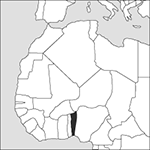
Source: MAPS IN MINUTES™ © RH Publications (1997)
Capital:
Porto Novo
Area:
112,622 sq km (43,484 sq miles)
Population:
9,877,292 (2013 est)
Currency:
1 CFA franc = 100 centimes
Religions:
Roman Catholic 27.1%; Muslim 24.4%; Vodun 17.3%; Protestant 10.4%
Ethnic Groups:
Fon 39.2%; Adja 15.2%; Yoruba 12.3%; Bariba 9.2%; Peulh 7.0%; Ottamari 6.1%; Yoa-Lokpa 4%; Dendi 2.5%
Languages:
French (official); Fon; Yoruba; other tribal languages
International Organizations:
UN; AU; Non-Aligned Movement; ECOWAS; Franc Zone; WTO
A West African country lying between Togo and Nigeria on the Gulf of Guinea.
Physical
Benin has a southern coastline of only 125 km (78 miles) but extends inland for 700 km (460 miles) to Niger. The coast is sandy with large lagoons and is hot and wet. Inland there is a fertile clay plain with thick tropical forest that rises to a sandy plateau with savannah vegetation. In the north the land falls away to the middle Niger River valley.
Economy
Benin has a primarily agricultural economy, with exports of cotton, foodstuffs, and textiles. There is some light industry, which includes textiles and food processing. Privatization of state-owned industries began in 2001 and has aided economic growth. Benin is largely an entrepôt state. Around three-quarters of its imports are en route to Nigeria. It also acts as a major outlet for the landlocked countries to the north.
History
Formerly known as Dahomey, this region was ruled by kings of Yoruba origin until the French occupied it in 1892. It was constituted a territory of French West Africa in 1904. As Dahomey, it became an independent republic within the French Community in 1960, after which periods of civilian government alternated with military rule. In 1972 it was declared a Marxist–Leninist state, and its name was altered (1975) to Benin. Under the leadership of Mathieu Kérékou (President 1972–91), Benin achieved greater domestic stability and international standing. In the country’s first free elections, held in 1991, Kérékou was defeated by his Prime Minister Nicéphore Soglo, whose government moved towards a free-market economy with the support of the IMF. Legislative elections in 1995 were indecisive and a coalition government was formed. However, presidential elections held in 1996 saw a surprise victory for the former dictator Kérékou, who was re-elected in 2001. He was succeeded in 2006 by Thomas Yayi Boni, who was re-elected in 2011. In the parliamentary elections in 2015, his party failed to win an overall majority, and he later announced he would follow the constitution and not stand for a third term. The presidential election, in March 2016, was won by the businessman, Patrice Talon, who defeated Yayi’s prime minister, Lionel Zinsou.
- Whitlam, Gough (1916–2014)
- Whitman two-film theory
- Whitney, Donald Ransom (1915–2001)
- Whitney, Eli (1765–1825)
- Whitney embedding theorem
- Whitson, Peggy (1960– )
- Whittington, Harry Blackmore
- Whittle, Peter (1927–2021)
- Whittle, Sir Frank
- Whitwellian
- WHO
- whois
- whole angle
- whole Earth composition
- whole-mantle convection
- whole number
- whole numbers
- whole plot
- whole-rock dating
- wholesale banking
- wholesale prices
- wholesaling
- wholly significant difference test
- whorl
- WHT